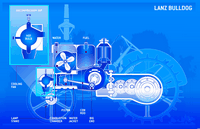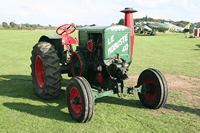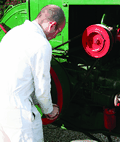Understanding the hot bulb engine

 Tractors with a hot bulb or semi-diesel engine were popular on the Continent for 30 years from the early 1920s, but failed to sell in Britain – the country where the hot bulb was invented.
Tractors with a hot bulb or semi-diesel engine were popular on the Continent for 30 years from the early 1920s, but failed to sell in Britain – the country where the hot bulb was invented.
Some farmers chose hot-bulb tractors for their reliability – one big cylinder and no electrical equipment means there is little to go wrong. Another attraction is that they burn almost any liquid fuel including diesel, paraffin, old sump oil or even a mixture of fuels, allowing thrifty owners to shop around for the best value.
There are also some disadvantages. Hot-bulb engines are awkward to start, inefficient and rough-running, which is why British farmers chose petrol-paraffin power instead of the hot bulb. By the mid-1950s both types were being replaced by diesel engines.
To find someone with hands-on experience of a hot-bulb tractor we went to Old Warden Park, Biggleswade, Bedfordshire, home of Shuttleworth College and of the large collection of early aircraft, cars and motor-cycles owned by the Shuttleworth Trust.
The collection also includes four old tractors including a 1919 Austin and a Ferguson A or “Ferguson-Brown” that worked on the estate, plus a Fordson Super Dexta used as an aircraft tug. Number four is a 1935 HSCS hot-bulb tractor that spent its working life in Australia.
 Restoration
Restoration
The Trust bought it 12 years ago because of the Shuttleworth family connection, restoring it in the workshops that maintain and repair the aircraft.
The 35hp HSCS helps to tow aircraft during flying displays, with Ken Hyde at the wheel. He has had plenty of practice starting the engine, a job involving a blowlamp, a stand and a box of matches.
Starting the engine from cold takes about 10 minutes if all goes well, he says. The matches light the blowlamp and the stand makes sure the flame is directed on the hot bulb at the top of the cylinder. When the hot bulb reaches its working temperature the engine is turned over manually, using the heavy flywheel. Handles attached to the flywheel automatically retract when they are released as the engine starts.
 Size
Size
Despite the huge size of the engine’s 9.8-litre cylinder, the 5.5:1 compression ratio, compared with about 17:1 for a modern diesel, means it is not hard to turn over.
“This engine starts quite well, but you must be careful, because any hot bulb engine runs backwards as easily as forwards,” says Mr Hyde. “Running backwards doesn’t damage the engine, but it does mean that the gears work the wrong way, providing only one forward speed and three in reverse.
If the engine stops accidentally it can be started again just by turning the flywheel – but you have to be quick. It takes only a minute or two for the hot bulb to cool below the critical temperature, which means using the blowlamp again. It is often tempting to leave the engine idling and waste fuel rather than face the complications of a cold start.
“Another criticism is that the tractor is uncomfortable to drive,” he says. “The weight of the piston makes the tractor rock backwards and forwards and you become very conscious of the movement.”
Related Links:

